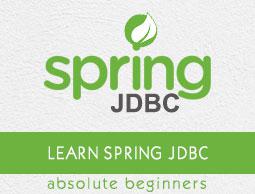Spring JDBC - JdbcTemplate Class
The org.springframework.jdbc.core.JdbcTemplate class is the central class in the JDBC core package. It simplifies the use of JDBC and helps to avoid common errors. It executes core JDBC workflow, leaving the application code to provide SQL and extract results. This class executes SQL queries or updates, initiating iteration over ResultSets and catching JDBC exceptions and translating them to the generic, more informative exception hierarchy defined in the org.springframework.dao package.
Class Declaration
Following is the declaration for org.springframework.jdbc.core.JdbcTemplate class −
public class JdbcTemplate
extends JdbcAccessor
implements JdbcOperations
Usage
Step 1 − Create a JdbcTemplate object using a configured datasource.
Step 2 − Use JdbcTemplate object methods to make database operations.
Example
Following example will demonstrate how to read a query using JdbcTemplate class. We'll read the available records in Student Table.
Syntax
String selectQuery = "select * from Student";
List <Student> students = jdbcTemplateObject.query(selectQuery, new StudentMapper());
Where,
selectQuery − Select query to read students.
jdbcTemplateObject − StudentJDBCTemplate object to read student object from the database.
StudentMapper − StudentMapper is a RowMapper object to map each fetched record to the student object.
To understand the above-mentioned concepts related to Spring JDBC, let us write an example which will select a query. To write our example, let us have a working Eclipse IDE in place and use the following steps to create a Spring application.
| Step |
Description |
| 1 |
Update the project Student created under chapter Spring JDBC - First Application. |
| 2 |
Update the bean configuration and run the application as explained below. |
Following is the content of the Data Access Object interface file StudentDAO.java.
package com.howcodex;
import java.util.List;
import javax.sql.DataSource;
public interface StudentDAO {
/**
* This is the method to be used to initialize
* database resources ie. connection.
*/
public void setDataSource(DataSource ds);
/**
* This is the method to be used to list down
* all the records from the Student table.
*/
public List<Student> listStudents();
}
Following is the content of the Student.java file.
package com.howcodex;
public class Student {
private Integer age;
private String name;
private Integer id;
public void setAge(Integer age) {
this.age = age;
}
public Integer getAge() {
return age;
}
public void setName(String name) {
this.name = name;
}
public String getName() {
return name;
}
public void setId(Integer id) {
this.id = id;
}
public Integer getId() {
return id;
}
}
Following is the content of the StudentMapper.java file.
package com.howcodex;
import java.sql.ResultSet;
import java.sql.SQLException;
import org.springframework.jdbc.core.RowMapper;
public class StudentMapper implements RowMapper<Student> {
public Student mapRow(ResultSet rs, int rowNum) throws SQLException {
Student student = new Student();
student.setId(rs.getInt("id"));
student.setName(rs.getString("name"));
student.setAge(rs.getInt("age"));
return student;
}
}
Following is the implementation class file StudentJDBCTemplate.java for the defined DAO interface StudentDAO.
package com.howcodex;
import java.util.List;
import javax.sql.DataSource;
import org.springframework.jdbc.core.JdbcTemplate;
public class StudentJDBCTemplate implements StudentDAO {
private DataSource dataSource;
private JdbcTemplate jdbcTemplateObject;
public void setDataSource(DataSource dataSource) {
this.dataSource = dataSource;
this.jdbcTemplateObject = new JdbcTemplate(dataSource);
}
public List<Student> listStudents() {
String SQL = "select * from Student";
List <Student> students = jdbcTemplateObject.query(SQL, new StudentMapper());
return students;
}
}
Following is the content of the MainApp.java file.
package com.howcodex;
import java.util.List;
import org.springframework.context.ApplicationContext;
import org.springframework.context.support.ClassPathXmlApplicationContext;
import com.howcodex.StudentJDBCTemplate;
public class MainApp {
public static void main(String[] args) {
ApplicationContext context = new ClassPathXmlApplicationContext("Beans.xml");
StudentJDBCTemplate studentJDBCTemplate =
(StudentJDBCTemplate)context.getBean("studentJDBCTemplate");
System.out.println("------Listing Multiple Records--------" );
List<Student> students = studentJDBCTemplate.listStudents();
for (Student record : students) {
System.out.print("ID : " + record.getId() );
System.out.print(", Name : " + record.getName() );
System.out.println(", Age : " + record.getAge());
}
}
}
Following is the configuration file Beans.xml.
<?xml version = "1.0" encoding = "UTF-8"?>
<beans xmlns = "http://www.springframework.org/schema/beans"
xmlns:xsi = "http://www.w3.org/2001/XMLSchema-instance"
xsi:schemaLocation = "http://www.springframework.org/schema/beans
http://www.springframework.org/schema/beans/spring-beans-3.0.xsd ">
<!-- Initialization for data source -->
<bean id="dataSource"
class = "org.springframework.jdbc.datasource.DriverManagerDataSource">
<property name = "driverClassName" value = "com.mysql.jdbc.Driver"/>
<property name = "url" value = "jdbc:mysql://localhost:3306/TEST"/>
<property name = "username" value = "root"/>
<property name = "password" value = "admin"/>
</bean>
<!-- Definition for studentJDBCTemplate bean -->
<bean id="studentJDBCTemplate"
class = "com.howcodex.StudentJDBCTemplate">
<property name = "dataSource" ref = "dataSource" />
</bean>
</beans>
Once you are done creating the source and bean configuration files, let us run the application. If everything is fine with your application, it will print the following message.
------Listing Multiple Records--------
ID : 1, Name : Zara, Age : 11
ID : 2, Name : Nuha, Age : 2
ID : 3, Name : Ayan, Age : 15


